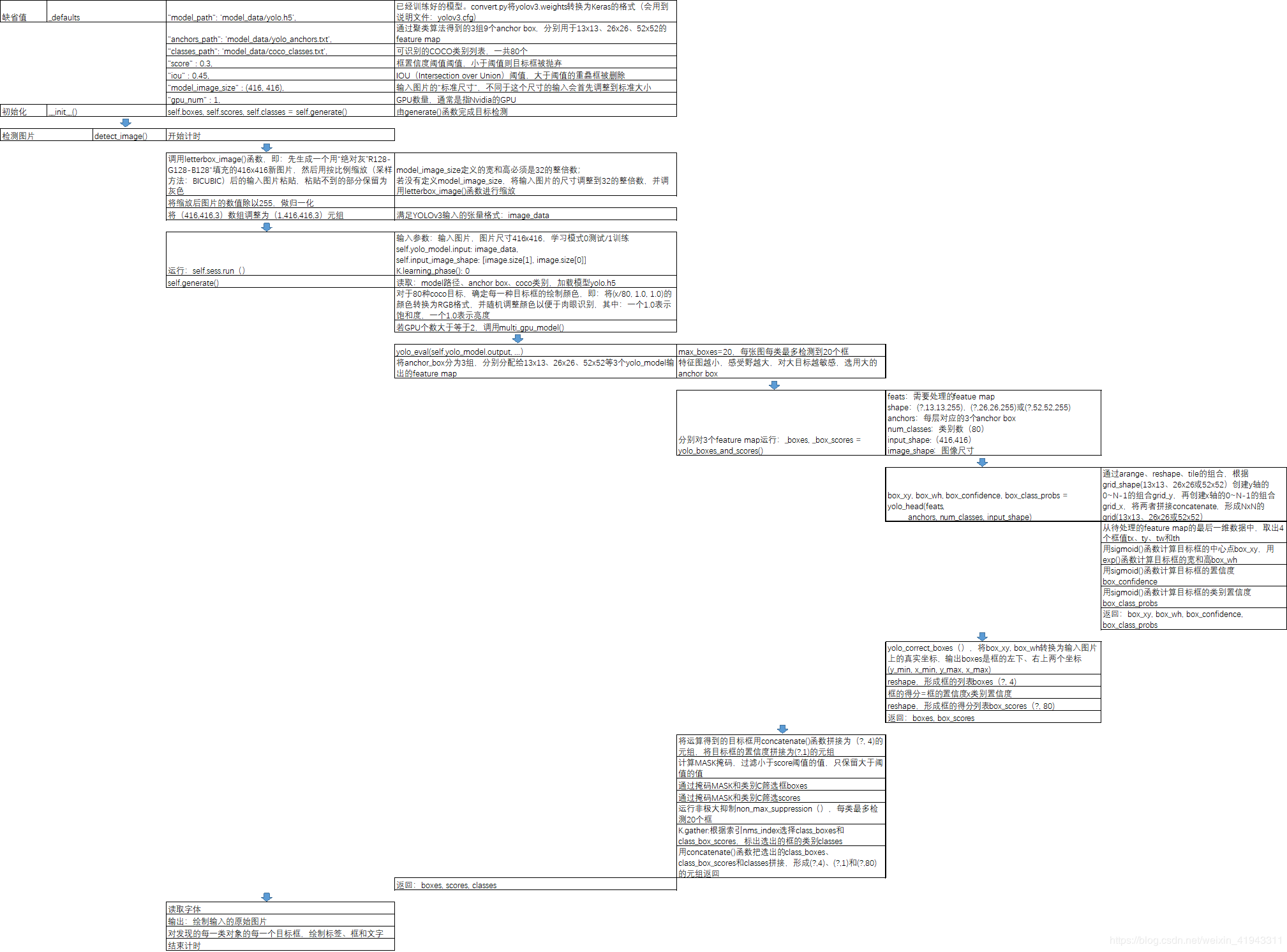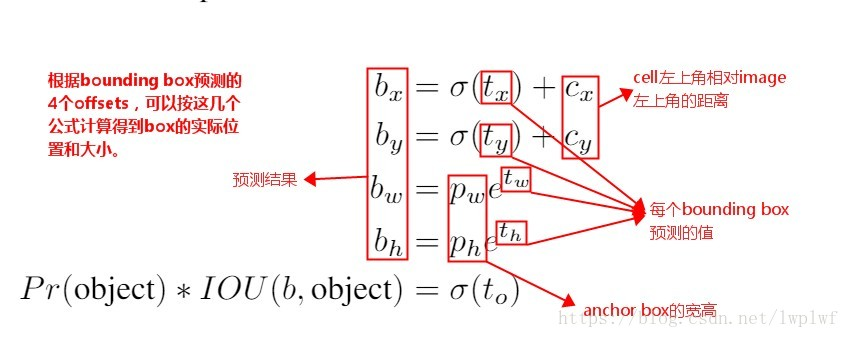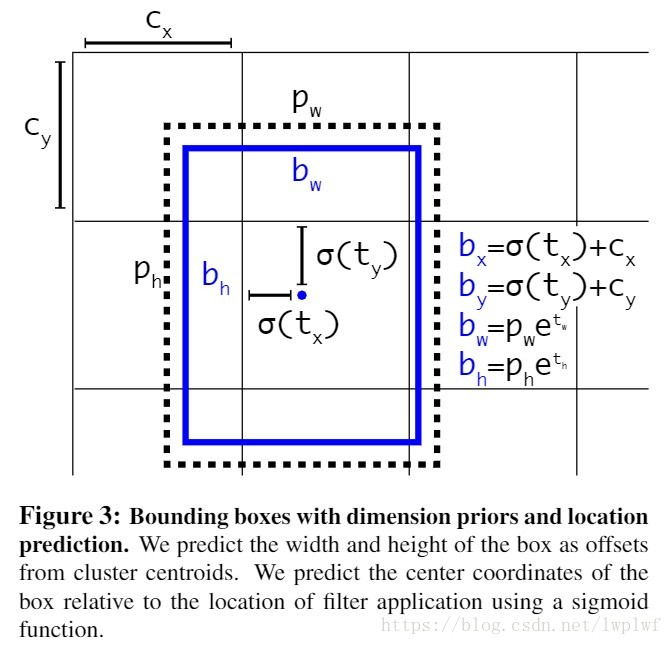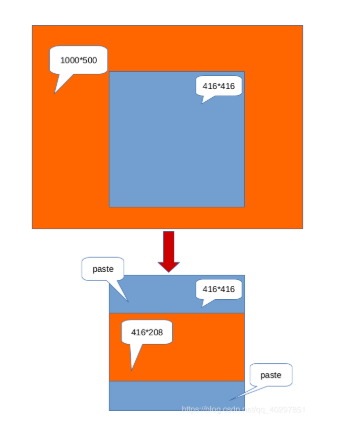yolo3各部分代码详解(超详细)
0.摘要
最近一段时间在学习yolo3,看了很多博客,理解了一些理论知识,但是学起来还是有些吃力,之后看了源码,才有了更进一步的理解。在这里,我不在赘述网络方面的代码,网络方面的代码比较容易理解,下面将给出整个yolo3代码的详解解析,整个源码中函数的作用以及调用关系见下图:

1.model.py
1.1 yolo_head()
yolo_head()函数的输入是Darknet53的最后输出的三个特征图feats,anchors,num_class,input_shpe,此函数的功能是将特征图的进行解码,这一步极为重要,如其中一个特征图的shape是(13,13,255),其实质就是对应着(13,13,3,85),分别对应着13*13个网格,每个网格3个anchors,85=(x,y,w,h,confident),此时box的xy是相对于网格的偏移量,所以还需要经过一些列的处理,处理方式见下图:


def yolo_head(feats, anchors, num_classes, input_shape, calc_loss=False):
"""Convert final layer features to bounding box parameters."""
num_anchors = len(anchors)#num_anchors=3
# Reshape to batch, height, width, num_anchors, box_params.
anchors_tensor = K.reshape(K.constant(anchors), [1, 1, 1, num_anchors, 2])
#anchors=anchors[anchors_mask[1]]=anchors[[6,7,8]]= [116,90], [156,198], [373,326]
"""#通过arange、reshape、tile的组合,根据grid_shape(13x13、26x26或52x52)创建y轴的0~N-1的组合grid_y,再创建x轴的0~N-1的组合grid_x,将两者拼接concatenate,形成NxN的grid(13x13、26x26或52x52)"""
grid_shape = K.shape(feats)[1:3] # height, width,#13x13或26x26或52x52
grid_y = K.tile(K.reshape(K.arange(0, stop=grid_shape[0]), [-1, 1, 1, 1]),
[1, grid_shape[1], 1, 1])
grid_x = K.tile(K.reshape(K.arange(0, stop=grid_shape[1]), [1, -1, 1, 1]),
[grid_shape[0], 1, 1, 1])
grid = K.concatenate([grid_x, grid_y])
grid = K.cast(grid, K.dtype(feats))
#cast函数用法:cast(x, dtype, name=None),x:待转换的张量,type:需要转换成什么类型
"""grid形式:(0,0),(0,1),(0,2)......(1,0),(1,1).....(12,12)"""
feats = K.reshape(
feats, [-1, grid_shape[0], grid_shape[1], num_anchors, num_classes + 5])
"""(batch_size,13,13,3,85)"""
"此时的xy为中心坐标,相对于左上角的中心坐标" # Adjust preditions to each spatial grid point and anchor size.
"""将预测值调整为真实值"""
"将中心点相对于网格的坐标转换成在整张图片中的坐标,相对于13/26/52的相对坐标"
"将wh转换成预测框的wh,并处以416归一化"
box_xy = (K.sigmoid(feats[..., :2]) + grid) / K.cast(grid_shape[::-1], K.dtype(feats))#实际上就是除以13或26或52
#box_xy = (K.sigmoid(feats[:,:,:,:2]) + grid) / K.cast(grid_shape[::-1], K.dtype(feats))
# ...操作符,在Python中,“...”(ellipsis)操作符,表示其他维度不变,只操作最前或最后1维;
box_wh = K.exp(feats[..., 2:4]) * anchors_tensor / K.cast(input_shape[::-1], K.dtype(feats))
box_confidence = K.sigmoid(feats[..., 4:5])
box_class_probs = K.sigmoid(feats[..., 5:])
#切片省略号的用法,省略前面左右的冒号,参考博客:https://blog.csdn.net/z13653662052/article/details/78010654?depth_1-utm_source=distribute.pc_relevant.none-task&utm_source=distribute.pc_relevant.none-task if calc_loss == True:
return grid, feats, box_xy, box_wh
return box_xy, box_wh, box_confidence, box_class_probs
#预测框相对于整张图片中心点的坐标与预测框的wh
1.2 yolo_correct_box()
此函数的功能是将yolo_head()输出,也即是box相对于整张图片的中心坐标转换成box的左上角右下角的坐标
def yolo_correct_boxes(box_xy, box_wh, input_shape, image_shape):
'''Get corrected boxes'''
'''对上面函数输出的预测的坐标进行修正
比如
image_shape
为[600,800],input_shape
为[300, 500],那么
new_shape
为[300, 400] offset
为[0, 0.125]
scales
为[0.5, 0.625]''' # 将box_xy, box_wh转换为输入图片上的真实坐标,输出boxes是框的左下、右上两个坐标(y_min, x_min, y_max, x_max)
# ...操作符,在Python中,“...”(ellipsis)操作符,表示其他维度不变,只操作最前或最后1维;
# np.array[i:j:s],当s<0时,i缺省时,默认为-1;j缺省时,默认为-len(a)-1;所以array[::-1]相当于array[-1:-len(a)-1:-1],也就是从最后一个元素到第一个元素复制一遍,即倒序
box_yx = box_xy[..., ::-1]#将xy坐标进行交换,反序(y,x)
box_hw = box_wh[..., ::-1]
input_shape = K.cast(input_shape, K.dtype(box_yx))
image_shape = K.cast(image_shape, K.dtype(box_yx))
new_shape = K.round(image_shape * K.min(input_shape/image_shape))
#.round用于取近似值,保留几位小数,第一个参数是一个浮点数,第二个参数是保留的小数位数,可选,如果不写的话默认保留到整数
offset = (input_shape-new_shape)/2./input_shape
scale = input_shape/new_shape
box_yx = (box_yx - offset) * scale
box_hw *= scale
"""获得预测框的左上角与右下角的坐标"""
box_mins = box_yx - (box_hw / 2.)
box_maxes = box_yx + (box_hw / 2.)
boxes = K.concatenate([
box_mins[..., 0:1], # y_min
box_mins[..., 1:2], # x_min
box_maxes[..., 0:1], # y_max
box_maxes[..., 1:2] # x_max
])#...操作符,在Python中,“...”(ellipsis)操作符,表示其他维度不变,只操作最前或最后1维; # Scale boxes back to original image shape.
boxes *= K.concatenate([image_shape, image_shape])
return boxes#得到预测框的左下角坐标与右上角坐标
1.3 yolo_box_and_score
获得box与得分
def yolo_boxes_and_scores(feats, anchors, num_classes, input_shape, image_shape):
'''Process Conv layer output'''
box_xy, box_wh, box_confidence, box_class_probs = yolo_head(feats,
anchors, num_classes, input_shape)
boxes = yolo_correct_boxes(box_xy, box_wh, input_shape, image_shape)
boxes = K.reshape(boxes, [-1, 4])#reshape,将不同网格的值转换为框的列表。即(?,13,13,3,4)->(?,4) ?:框的数目
box_scores = box_confidence * box_class_probs
box_scores = K.reshape(box_scores, [-1, num_classes])#reshape,将框的得分展平,变为(?,80); ?:框的数目
return boxes, box_scores#返回预测框的左下角与右上角的坐标与得分
1.4 yolo_eval()
此函数的作用是删除冗余框,保留最优框,用到非极大值抑制算法
def yolo_eval(yolo_outputs,
anchors,
num_classes,
image_shape,
max_boxes=20,
score_threshold=.6,
iou_threshold=.5):
"""Evaluate YOLO model on given input and return filtered boxes."""
""" yolo_outputs #模型输出,格式如下【(?,13,13,255)(?,26,26,255)(?,52,52,255)】 ?:bitch size; 13-26-52:多尺度预测; 255:预测值(3*(80+5))
anchors, #[(10,13), (16,30), (33,23), (30,61), (62,45), (59,119), (116,90), (156,198),(373,326)]
num_classes, # 类别个数,coco集80类
image_shape, #placeholder类型的TF参数,默认(416, 416);
max_boxes=20, #每张图每类最多检测到20个框同类别框的IoU阈值,大于阈值的重叠框被删除,重叠物体较多,则调高阈值,重叠物体较少,则调低阈值
score_threshold=.6, #框置信度阈值,小于阈值的框被删除,需要的框较多,则调低阈值,需要的框较少,则调高阈值;
iou_threshold=.5): #同类别框的IoU阈值,大于阈值的重叠框被删除,重叠物体较多,则调高阈值,重叠物体较少,则调低阈值"""
num_layers = len(yolo_outputs)# #yolo的输出层数;num_layers = 3 -> 13-26-52
anchor_mask = [[6,7,8], [3,4,5], [0,1,2]] if num_layers==3 else [[3,4,5], [1,2,3]] # default setting
# 每层分配3个anchor box.如13*13分配到[6,7,8]即[(116,90)(156,198)(373,326)]
input_shape = K.shape(yolo_outputs[0])[1:3] * 32
# 输入shape(?,13,13,255);即第一维和第二维分别*32 ->13*32=416; input_shape:(416,416)
#yolo_outputs=[(batch_size,13,13,255),(batch_size,26,26,255),(batch_size,52,52,255)]
#input_shape=416*416
boxes = []
box_scores = []
for l in range(num_layers):
_boxes, _box_scores = yolo_boxes_and_scores(yolo_outputs[l],
anchors[anchor_mask[l]], num_classes, input_shape, image_shape)
boxes.append(_boxes)
box_scores.append(_box_scores)
boxes = K.concatenate(boxes, axis=0)
box_scores = K.concatenate(box_scores, axis=0) #K.concatenate:将数据展平 ->(?,4) #可能会产生很多个预选框,需要经过(1)阈值的删选,(2)非极大值抑制的删选
mask = box_scores >= score_threshold#得分大于置信度为True,否则为Flase
max_boxes_tensor = K.constant(max_boxes, dtype='int32')
boxes_ = []
scores_ = []
classes_ = []
"""
# ---------------------------------------#
# 1、取出每一类得分大于score_threshold
# 的框和得分
# 2、对得分进行非极大抑制
# ---------------------------------------#
# 对每一个类进行判断"""
for c in range(num_classes):
# TODO: use keras backend instead of tf.
class_boxes = tf.boolean_mask(boxes, mask[:, c])#将输入的数组挑出想要的数据输出,将得分大于阈值的坐标挑选出来
#将第c类中得分大于阈值的坐标挑选出来
class_box_scores = tf.boolean_mask(box_scores[:, c], mask[:, c])
# 将第c类中得分大于阈值的框挑选出来
"""非极大值抑制部分"""
# 非极大抑制,去掉box重合程度高的那一些
"""原理:(1)从最大概率矩形框F开始,分别判断A~E与F的重叠度IOU是否大于某个设定的阈值; (2)假设B、D与F的重叠度超过阈值,那么就扔掉B、D;并标记第一个矩形框F,是我们保留下来的。 (3)从剩下的矩形框A、C、E中,选择概率最大的E,然后判断E与A、C的重叠度,重叠度大于一定的阈值,那么就扔掉;并标记E是我们保留下来的第二个矩形框。 就这样一直重复,找到所有被保留下来的矩形框。"""
nms_index = tf.image.non_max_suppression(
class_boxes, class_box_scores, max_boxes_tensor, iou_threshold=iou_threshold)
class_boxes = K.gather(class_boxes, nms_index)
class_box_scores = K.gather(class_box_scores, nms_index)
classes = K.ones_like(class_box_scores, 'int32') * c#将class_box_scores中的数变成1
boxes_.append(class_boxes)
scores_.append(class_box_scores)
classes_.append(classes)
boxes_ = K.concatenate(boxes_, axis=0)
scores_ = K.concatenate(scores_, axis=0)
classes_ = K.concatenate(classes_, axis=0)
#return 经过非极大值抑制保留下来的一个框 return boxes_, scores_, classes_
1.5 preprocess_true_box()
def preprocess_true_boxes(true_boxes, input_shape, anchors, num_classes):
'''
在preprocess_true_boxes中,输入: true_boxes:检测框,批次数16,最大框数20,每个框5个值,4个边界点和1个类别序号,如(16, 20, 5);
input_shape:图片尺寸,如(416, 416);
anchors:anchor box列表;
num_classes:类别的数量;
Preprocess true boxes to training input format Parameters
----------
true_boxes: array, shape=(m, T, 5)
Absolute x_min, y_min, x_max, y_max, class_id relative to input_shape.
input_shape: array-like, hw, multiples of 32
anchors: array, shape=(N, 2), wh
num_classes: integer Returns
-------
y_true: list of array, shape like yolo_outputs, xywh are reletive value '''
# 检查有无异常数据 即txt提供的box id 是否存在大于 num_class的情况
# true_boxes.shape = (图片张数,每张图片box个数,5)(5是左上右下点坐标加上类别下标)
assert (true_boxes[..., 4]<num_classes).all(), 'class id must be less than num_classes'
num_layers = len(anchors)//3 # default setting
anchor_mask = [[6,7,8], [3,4,5], [0,1,2]] if num_layers==3 else [[3,4,5], [1,2,3]] true_boxes = np.array(true_boxes, dtype='float32')
input_shape = np.array(input_shape, dtype='int32') # [416 416] shape(2,)
# 将每个box的左上点和右下点坐标相加除2,即取中点!
"""计算true_boxes: true_boxes:真值框,左上和右下2个坐标值和1个类别,如[184, 299, 191, 310, 0.0],结构是(16, 20, 5),16是批次数,20是框的最大数,5是框的5个值;
boxes_xy:xy是box的中心点,结构是(16, 20, 2);
boxes_wh:wh是box的宽和高,结构也是(16, 20, 2);
input_shape:输入尺寸416x416;
true_boxes:第0和1位设置为xy,除以416,归一化,第2和3位设置为wh,除以416,归一化,如[0.449, 0.730, 0.016, 0.026, 0.0]。"""
boxes_xy = (true_boxes[..., 0:2] + true_boxes[..., 2:4]) // 2
# 得到box宽高
boxes_wh = true_boxes[..., 2:4] - true_boxes[..., 0:2]
# 中心坐标 和 宽高 都变成 相对于input_shape的比例
true_boxes[..., 0:2] = boxes_xy/input_shape[::-1]
true_boxes[..., 2:4] = boxes_wh/input_shape[::-1]
# 这个m应该是batch的大小 即是输入图片的数量
m = true_boxes.shape[0]
# grid_shape [13,13 ] [26,26] [52,52]
grid_shapes = [input_shape//{0:32, 1:16, 2:8}[l] for l in range(num_layers)]
#y_true是全0矩阵(np.zeros)列表,即[(16,13,13,3,6), (16,26,26,3,6), (16,52,52,3,6)]
y_true = [np.zeros((m,grid_shapes[l][0],grid_shapes[l][1],len(anchor_mask[l]),5+num_classes),
dtype='float32') for l in range(num_layers)]
# y_true m*13*13*3*(5+num_clasess)
# m*26*26*3*(5+num_classes)
# m*52*52*3*(5+num_classes)
# Expand dim to apply broadcasting. # Expand dim to apply broadcasting.
#在原先axis出添加一个维度,由(9,2)转为(1,9,2)
anchors = np.expand_dims(anchors, 0)
# 网格中心为原点(即网格中心坐标为 (0,0) ), 计算出anchor 右下角坐标
anchor_maxes = anchors / 2.
#计算出左上标
anchor_mins = -anchor_maxes
# 去掉异常数据
valid_mask = boxes_wh[..., 0]>0 for b in range(m):
# Discard zero rows.
wh = boxes_wh[b, valid_mask[b]]
if len(wh)==0: continue
# Expand dim to apply broadcasting.
wh = np.expand_dims(wh, -2)
box_maxes = wh / 2.
box_mins = -box_maxes
# # 假设 bouding box 的中心也位于网格的中心 """计算标注框box与anchor box的iou值,计算方式很巧妙: box_mins的shape是(7,1,2),anchor_mins的shape是(1,9,2),intersect_mins的shape是(7,9,2),即两两组合的值;
intersect_area的shape是(7,9);
box_area的shape是(7,1);
anchor_area的shape是(1,9);
iou的shape是(7,9);
IoU数据,即anchor box与检测框box,两两匹配的iou值"""
intersect_mins = np.maximum(box_mins, anchor_mins)#逐位比较
intersect_maxes = np.minimum(box_maxes, anchor_maxes)
intersect_wh = np.maximum(intersect_maxes - intersect_mins, 0.)
intersect_area = intersect_wh[..., 0] * intersect_wh[..., 1]#宽*高
box_area = wh[..., 0] * wh[..., 1]
anchor_area = anchors[..., 0] * anchors[..., 1]
iou = intersect_area / (box_area + anchor_area - intersect_area) # Find best anchor for each true box
best_anchor = np.argmax(iou, axis=-1) """设置y_true的值: t是box的序号;n是最优anchor的序号;l是层号;
如果最优anchor在层l中,则设置其中的值,否则默认为0;
true_boxes是(16, 20, 5),即批次、box数、框值;
true_boxes[b, t, 0],其中b是批次序号、t是box序号,第0位是x,第1位是y;
grid_shapes是3个检测图的尺寸,将归一化的值,与框长宽相乘,恢复为具体值;
k是在anchor box中的序号;
c是类别,true_boxes的第4位;
将xy和wh放入y_true中,将y_true的第4位框的置信度设为1,将y_true第5~n位的类别设为1;"""
for t, n in enumerate(best_anchor):
# 遍历anchor 尺寸 3个尺寸
# 因为此时box 已经和一个anchor box匹配上,看这个anchor box属于那一层,小,中,大,然后将其box分配到那一层
for l in range(num_layers):
if n in anchor_mask[l]:
#因为grid_shape格式是hw所以是x*grid_shapes[l][1]=x*w,求出对应所在网格的横坐标,这里的x是相对于整张图片的相对坐标,
# 是在原先坐标上除以了w,所以现在要乘以w
i = np.floor(true_boxes[b,t,0]*grid_shapes[l][1]).astype('int32')
#np.around 四舍五入
#np.floor向下取整
#np.ceil向上取整
#np.where条件选取
# np.floor 返回不大于输入参数的最大整数。 即对于输入值 x ,将返回最大的整数 i ,使得 i <= x。
# true_boxes x,y,w,h, 此时x y w h都是相对于整张图像的
# 第b个图像 第 t个 bounding box的 x 乘以 第l个grid shap的x(grid shape 格式是hw,
# 因为input_shape格式是hw)
# 找到这个bounding box落在哪个cell的中心
#i,j是所在网格的位置
j = np.floor(true_boxes[b,t,1]*grid_shapes[l][0]).astype('int32')
# 找到n 在 anchor_box的索引位置
k = anchor_mask[l].index(n)
# 得到box的id
c = true_boxes[b,t, 4].astype('int32')
# 第b个图像 第j行 i列 第k个anchor x,y,w,h,confindence,类别概率
y_true[l][b, j, i, k, 0:4] = true_boxes[b,t, 0:4]
y_true[l][b, j, i, k, 4] = 1
# 置信度是1 因为含有目标
y_true[l][b, j, i, k, 5+c] = 1
# 类别的one-hot编码 return y_true
1.6 yolo_loss
此函数定义损失函数,损失函数包括三个部分,坐标损失,置信度损失,类别损失:

def yolo_loss(args, anchors, num_classes, ignore_thresh=.5, print_loss=False):
"""true_boxes : 实际框的位置和类别,我们的输入。三个维度:
第一个维度:图片张数
第二个维度:一张图片中有几个实际框
第三个维度: [x, y, w, h, class],x,y 是实际框的中心点坐标,w,h 是框的宽度和高度。x,y,w,h 均是除以图片分辨率得到的[0,1]范围的值。
anchors : 实际anchor boxes 的值,论文中使用了五个。[w,h],都是相对于gird cell 长宽的比值。二个维度:
第一个维度:anchor boxes的数量,这里是5
第二个维度:[w,h],w,h,都是相对于gird cell 长宽的比值。
"""
'''Return yolo_loss tensor Parameters
----------
yolo_outputs: list of tensor, the output of yolo_body or tiny_yolo_body
y_true: list of array, the output of preprocess_true_boxes
anchors: array, shape=(N, 2), wh
num_classes: integer
ignore_thresh: float, the iou threshold whether to ignore object confidence loss Returns
-------
loss: tensor, shape=(1,) '''
num_layers = len(anchors)//3 # default setting
yolo_outputs = args[:num_layers]
y_true = args[num_layers:]
anchor_mask = [[6,7,8], [3,4,5], [0,1,2]] if num_layers==3 else [[3,4,5], [1,2,3]]
input_shape = K.cast(K.shape(yolo_outputs[0])[1:3] * 32, K.dtype(y_true[0]))
grid_shapes = [K.cast(K.shape(yolo_outputs[l])[1:3], K.dtype(y_true[0])) for l in range(num_layers)]
loss = 0
m = K.shape(yolo_outputs[0])[0] # batch size, tensor
mf = K.cast(m, K.dtype(yolo_outputs[0])) for l in range(num_layers):
object_mask = y_true[l][..., 4:5]#置信度
true_class_probs = y_true[l][..., 5:]#类别 grid, raw_pred, pred_xy, pred_wh = yolo_head(yolo_outputs[l],
anchors[anchor_mask[l]], num_classes, input_shape, calc_loss=True)
pred_box = K.concatenate([pred_xy, pred_wh]) # Darknet raw box to calculate loss.
# 这是对x,y,w,b转换公式的反变换
raw_true_xy = y_true[l][..., :2]*grid_shapes[l][::-1] - grid
raw_true_wh = K.log(y_true[l][..., 2:4] / anchors[anchor_mask[l]] * input_shape[::-1])
# 这部操作是避免出现log(0) = 负无穷,故当object_mask置信率接近0是返回全0结果
# K.switch(条件函数,返回值1,返回值2)其中1,2要等shape
raw_true_wh = K.switch(object_mask, raw_true_wh, K.zeros_like(raw_true_wh)) # avoid log(0)=-inf
#提升针对小物体的小技巧:针对 YOLOv3来说,regression损失会乘一个(2-w*h)的比例系数,
# w 和 h 分别是ground truth 的宽和高。如果不减去 w*h,AP 会有一个明显下降。如果继续往上加,如 (2-w*h)*1.5,总体的 AP 还会涨一个点左右(包括验证集和测试集),大概是因为 COCO 中小物体实在太多的原因。 box_loss_scale = 2 - y_true[l][...,2:3]*y_true[l][...,3:4] # Find ignore mask, iterate over each of batch.
ignore_mask = tf.TensorArray(K.dtype(y_true[0]), size=1, dynamic_size=True)
object_mask_bool = K.cast(object_mask, 'bool')
##将真实标定的数据置信率转换为T or F的掩膜 def loop_body(b, ignore_mask):
true_box = tf.boolean_mask(y_true[l][b,...,0:4], object_mask_bool[b,...,0])#挑选出置信度大于0的框的相应的坐标,truebox形式为中心坐标xy与hw iou = box_iou(pred_box[b], true_box)#计算iou,pre_box是通过yolo_head解码之后的xywh
best_iou = K.max(iou, axis=-1)#选取最大iou的
ignore_mask = ignore_mask.write(b, K.cast(best_iou<ignore_thresh, K.dtype(true_box)))
return b+1, ignore_mask
_, ignore_mask = K.control_flow_ops.while_loop(lambda b,*args: b<m, loop_body, [0, ignore_mask])
ignore_mask = ignore_mask.stack()#将一个列表中维度数目为R的张量堆积起来形成维度为R+1的新张量
ignore_mask = K.expand_dims(ignore_mask, -1) # K.binary_crossentropy is helpful to avoid exp overflow.
xy_loss = object_mask * box_loss_scale * K.binary_crossentropy(raw_true_xy, raw_pred[...,0:2], from_logits=True)
wh_loss = object_mask * box_loss_scale * 0.5 * K.square(raw_true_wh-raw_pred[...,2:4])
confidence_loss = object_mask * K.binary_crossentropy(object_mask, raw_pred[...,4:5], from_logits=True)+ \
(1-object_mask) * K.binary_crossentropy(object_mask, raw_pred[...,4:5], from_logits=True) * ignore_mask
class_loss = object_mask * K.binary_crossentropy(true_class_probs, raw_pred[...,5:], from_logits=True) xy_loss = K.sum(xy_loss) / mf
wh_loss = K.sum(wh_loss) / mf
confidence_loss = K.sum(confidence_loss) / mf
class_loss = K.sum(class_loss) / mf
loss += xy_loss + wh_loss + confidence_loss + class_loss
if print_loss:
loss = tf.Print(loss, [loss, xy_loss, wh_loss, confidence_loss, class_loss, K.sum(ignore_mask)], message='loss: ')
return loss
2.train.py
整个训练分为两个阶段,第一个阶段为0~50epoch,训练最后的loss层,前面的层被冻结,第二个阶段为50~100个epoch训练前面的层
def _main():
annotation_path = '2007_train.txt'
log_dir = 'logs/000/'
classes_path = 'model_data/voc_classes.txt'
anchors_path = 'model_data/yolo_anchors.txt'
class_names = get_classes(classes_path)
num_classes = len(class_names)
anchors = get_anchors(anchors_path) input_shape = (416,416) # multiple of 32, hw is_tiny_version = len(anchors)==6 # default setting
if is_tiny_version:
model = create_tiny_model(input_shape, anchors, num_classes,
freeze_body=2, weights_path='model_data/tiny_yolo_weights.h5')
else:
model = create_model(input_shape, anchors, num_classes,
freeze_body=2, weights_path='model_data/yolo_weights.h5') # make sure you know what you freeze logging = TensorBoard(log_dir=log_dir)
checkpoint = ModelCheckpoint(log_dir + 'ep{epoch:03d}-loss{loss:.3f}-val_loss{val_loss:.3f}.h5',
monitor='val_loss', save_weights_only=True, save_best_only=True, period=3)
reduce_lr = ReduceLROnPlateau(monitor='val_loss', factor=0.1, patience=3, verbose=1)
"""monitor:被监测的量
factor:每次减少学习率的因子,学习率将以lr = lr*factor的形式被减少
patience:当patience个epoch过去而模型性能不提升时,学习率减少的动作会被触发
mode:‘auto’,‘min’,‘max’之一,在min模式下,如果检测值触发学习率减少。在max模式下,当检测值不再上升则触发学习率减少。
epsilon:阈值,用来确定是否进入检测值的“平原区”
cooldown:学习率减少后,会经过cooldown个epoch才重新进行正常操作
min_lr:学习率的下限"""
early_stopping = EarlyStopping(monitor='val_loss', min_delta=0, patience=10, verbose=1)
"""monitor: 被监测的数据。
min_delta: 在被监测的数据中被认为是提升的最小变化, 例如,小于 min_delta 的绝对变化会被认为没有提升。
patience: 没有进步的训练轮数,在这之后训练就会被停止。
verbose: 详细信息模式。
mode: {auto, min, max} 其中之一。 在 min 模式中, 当被监测的数据停止下降,训练就会停止;在 max 模式中,当被监测的数据停止上升,训练就会停止;在 auto 模式中,方向会自动从被监测的数据的名字中判断出来。
baseline: 要监控的数量的基准值。 如果模型没有显示基准的改善,训练将停止。
restore_best_weights: 是否从具有监测数量的最佳值的时期恢复模型权重。 如果为 False,则使用在训练的最后一步获得的模型权重""" val_split = 0.1
with open(annotation_path) as f:
lines = f.readlines()
np.random.seed(10101)
np.random.shuffle(lines)
np.random.seed(None)
num_val = int(len(lines)*val_split)
num_train = len(lines) - num_val # Train with frozen layers first, to get a stable loss.
# Adjust num epochs to your dataset. This step is enough to obtain a not bad model.
if True:
model.compile(optimizer=Adam(lr=1e-3), loss={
# use custom yolo_loss Lambda layer.
# # 使用定制的 yolo_loss Lambda层
'yolo_loss': lambda y_true, y_pred: y_pred})
#解释:模型compile时传递的是自定义的loss,而把loss写成一个层融合到model里面后,
# y_pred就是loss。自定义损失函数规定要以y_true, y_pred为参数 batch_size = 32
print('Train on {} samples, val on {} samples, with batch size {}.'.format(num_train, num_val, batch_size))
model.fit_generator(data_generator_wrapper(lines[:num_train], batch_size, input_shape, anchors, num_classes),
steps_per_epoch=max(1, num_train//batch_size),
validation_data=data_generator_wrapper(lines[num_train:], batch_size, input_shape, anchors, num_classes),
validation_steps=max(1, num_val//batch_size),
epochs=50,
initial_epoch=0,
callbacks=[logging, checkpoint])
model.save_weights(log_dir + 'trained_weights_stage_1.h5') # Unfreeze and continue training, to fine-tune.
# Train longer if the result is not good.
if True:
for i in range(len(model.layers)):
model.layers[i].trainable = True
model.compile(optimizer=Adam(lr=1e-4), loss={'yolo_loss': lambda y_true, y_pred: y_pred}) # recompile to apply the change
print('Unfreeze all of the layers.') batch_size = 32 # note that more GPU memory is required after unfreezing the body
print('Train on {} samples, val on {} samples, with batch size {}.'.format(num_train, num_val, batch_size))
model.fit_generator(data_generator_wrapper(lines[:num_train], batch_size, input_shape, anchors, num_classes),
steps_per_epoch=max(1, num_train//batch_size),
validation_data=data_generator_wrapper(lines[num_train:], batch_size, input_shape, anchors, num_classes),
validation_steps=max(1, num_val//batch_size),
epochs=100,
initial_epoch=50,
callbacks=[logging, checkpoint, reduce_lr, early_stopping])
model.save_weights(log_dir + 'trained_weights_final.h5') # Further training if needed. def get_classes(classes_path):
'''loads the classes'''
with open(classes_path) as f:
class_names = f.readlines()
class_names = [c.strip() for c in class_names]
return class_names def get_anchors(anchors_path):
'''loads the anchors from a file'''
with open(anchors_path) as f:
anchors = f.readline()
anchors = [float(x) for x in anchors.split(',')]
return np.array(anchors).reshape(-1, 2) def create_model(input_shape, anchors, num_classes, load_pretrained=True, freeze_body=2,
weights_path='model_data/yolo_weights.h5'):
'''create the training model'''
K.clear_session() # get a new session
image_input = Input(shape=(None, None, 3))
h, w = input_shape
num_anchors = len(anchors) y_true = [Input(shape=(h//{0:32, 1:16, 2:8}[l], w//{0:32, 1:16, 2:8}[l], \
num_anchors//3, num_classes+5)) for l in range(3)] model_body = yolo_body(image_input, num_anchors//3, num_classes)
print('Create YOLOv3 model with {} anchors and {} classes.'.format(num_anchors, num_classes)) if load_pretrained:
model_body.load_weights(weights_path, by_name=True, skip_mismatch=True)
print('Load weights {}.'.format(weights_path))
"""根据预训练权重的地址weights_path,加载权重文件,设置参数为,按名称对应by_name,
略过不匹配skip_mismatch; 选择冻结模式:模式1是冻结185层,模式2是保留最底部3层,其余全部冻结。
整个模型共有252层;将所冻结的层,设置为不可训练,trainable=False;"""
if freeze_body in [1, 2]:
# Freeze darknet53 body or freeze all but 3 output layers.
num = (185, len(model_body.layers)-3)[freeze_body-1]
for i in range(num): model_body.layers[i].trainable = False
print('Freeze the first {} layers of total {} layers.'.format(num, len(model_body.layers)))
"""Lambda是Keras的自定义层,输入为model_body.output和y_true,输出output_shape是(1,),即一个损失值; 自定义Lambda层的名字name为yolo_loss; 层的参数是锚框列表anchors、类别数num_classes和IoU阈值ignore_thresh。
其中,ignore_thresh用于在物体置信度损失中过滤IoU较小的框; yolo_loss是损失函数的核心逻辑。"""
model_loss = Lambda(yolo_loss, output_shape=(1,), name='yolo_loss',
arguments={'anchors': anchors, 'num_classes': num_classes, 'ignore_thresh': 0.5})(
[*model_body.output, *y_true])
"""把loss写成一个层,作为最后的输出,搭建模型的时候,就只需要将模型的output定义为loss
,而compile的时候,直接将loss设置为y_pred(因为模型的输出就是loss,所以y_pred就是loss),
无视y_true,训练的时候,y_true随便扔一个符合形状的数组进去就行了"""
#keras.layer.Lambda将任意表达式封装为 Layer 对象
#keras.layers.Lambda(function, output_shape=None, mask=None, arguments=None)
#function: 需要封装的函数。 将输入张量作为第一个参数。
# output_shape: 预期的函数输出尺寸。可以是元组或者函数。 如果是元组,它只指定第一个维度;
# arguments: 可选的。传递给函数function的关键字参数。 model = Model([model_body.input, *y_true], model_loss)
#构建了以图片数据和图片标签(y_true)为输入,
# 模型损失(model_loss)为输出(y_pred)的模型 model。 return model def create_tiny_model(input_shape, anchors, num_classes, load_pretrained=True, freeze_body=2,
weights_path='model_data/tiny_yolo_weights.h5'):
'''create the training model, for Tiny YOLOv3'''
K.clear_session() # get a new session
image_input = Input(shape=(None, None, 3))
h, w = input_shape
num_anchors = len(anchors) y_true = [Input(shape=(h//{0:32, 1:16}[l], w//{0:32, 1:16}[l], \
num_anchors//2, num_classes+5)) for l in range(2)] model_body = tiny_yolo_body(image_input, num_anchors//2, num_classes)
print('Create Tiny YOLOv3 model with {} anchors and {} classes.'.format(num_anchors, num_classes)) if load_pretrained:
model_body.load_weights(weights_path, by_name=True, skip_mismatch=True)
print('Load weights {}.'.format(weights_path))
if freeze_body in [1, 2]:
# Freeze the darknet body or freeze all but 2 output layers.
num = (20, len(model_body.layers)-2)[freeze_body-1]
for i in range(num): model_body.layers[i].trainable = False
print('Freeze the first {} layers of total {} layers.'.format(num, len(model_body.layers))) model_loss = Lambda(yolo_loss, output_shape=(1,), name='yolo_loss',
arguments={'anchors': anchors, 'num_classes': num_classes, 'ignore_thresh': 0.7})(
[*model_body.output, *y_true])
model = Model([model_body.input, *y_true], model_loss) return model def data_generator(annotation_lines, batch_size, input_shape, anchors, num_classes): '''data generator for fit_generator
annotation_lines:标注数据的行,每行数据包含图片路径,和框的位置信息,种类
batch_size:每批图片的大小
input_shape: 图片的输入尺寸
anchors: 大小
num_classes: 类别数
''' n = len(annotation_lines)
i = 0
while True:
image_data = []
box_data = []
for b in range(batch_size):
if i==0:
np.random.shuffle(annotation_lines)
image, box = get_random_data(annotation_lines[i], input_shape, random=True)#从标记的样本分离image与box,得到样本图片与样本label
image_data.append(image)
box_data.append(box)
i = (i+1) % n
image_data = np.array(image_data)
box_data = np.array(box_data)
y_true = preprocess_true_boxes(box_data, input_shape, anchors, num_classes)
yield [image_data, *y_true], np.zeros(batch_size) def data_generator_wrapper(annotation_lines, batch_size, input_shape, anchors, num_classes):
n = len(annotation_lines)
if n==0 or batch_size<=0: return None
return data_generator(annotation_lines, batch_size, input_shape, anchors, num_classes) if __name__ == '__main__':
_main()
3.utils.py
3.1 letter_image_box(),此函数的作用主要是将输入的图片进行等比例缩小,并在空余地方填成灰色
def letterbox_image(image, size):
'''resize image with unchanged aspect ratio using padding'''
iw, ih = image.size#图像初始的大小,任意值 以(1000,500)为例
w, h = size #模型要求的(416,416)
scale = min(w/iw, h/ih)#416/1000 0.416<0.832 ,416/500
nw = int(iw*scale) #416/1000*1000=416
nh = int(ih*scale)#416/1000*400=208 image = image.resize((nw,nh), Image.BICUBIC)
new_image = Image.new('RGB', size, (128,128,128))#new : 这个函数创建一幅给定模式(mode)和尺寸(size)的图片。如果省略 color 参数,则创建的图片被黑色填充满,
# 如果 color 参数是 None 值,则图片还没初始化
new_image.paste(image, ((w-nw)//2, (h-nh)//2)) #w-nw=0,(h-nh)//2=(416-208)//2=108
return new_image
它的作用如下:

3.2 get_random_data()
此函数的功能主要是进行数据增强与输入图像预处理(同letter_image_box)
def get_random_data(annotation_line, input_shape, random=True, max_boxes=20, jitter=.3, hue=.1, sat=1.5, val=1.5, proc_img=True):
'''random preprocessing for real-time data augmentation
annotation_lines:标注数据的行,每行数据包含图片路径,和框的位置信息,种类
return:imagedata是经过resize并填充的样本图片,resize成(416,416),并填充灰度
boxdata是每张image中做的标记label,shpe,对应着truebox,批次数16,最大框数20,每个框5个值,4个边界点和1个类别序号,如(16, 20, 5)
为(,batchsize,maxbox,5),每张图片最多的有maxbox个类,5为左上右下的坐标'''
line = annotation_line.split()#删除空格
image = Image.open(line[0])
iw, ih = image.size
h, w = input_shape#(416,416)
box = np.array([np.array(list(map(int,box.split(',')))) for box in line[1:]]) if not random:
# resize image
#将图片等比例转换为416x416的图片,其余用灰色填充,
# 即(128, 128, 128),同时颜色值转换为0~1之间,即每个颜色值除以255; scale = min(w/iw, h/ih)
nw = int(iw*scale)
nh = int(ih*scale)
dx = (w-nw)//2
dy = (h-nh)//2
image_data=0
if proc_img:
image = image.resize((nw,nh), Image.BICUBIC)
new_image = Image.new('RGB', (w,h), (128,128,128))
new_image.paste(image, (dx, dy))
image_data = np.array(new_image)/255.
# 上面的作用和letter_box一致,加了一个把rgb范围变成0-1
# correct boxes max_boxes=20 # correct boxes
# 将边界框box等比例缩小,再加上填充的偏移量dx和dy,因为新的图片部分用灰色填充,影
# 响box的坐标系,box最多有max_boxes个,即20个
box_data = np.zeros((max_boxes,5))#shap->(20,5)
if len(box)>0:
np.random.shuffle(box)
if len(box)>max_boxes: box = box[:max_boxes]
box[:, [0,2]] = box[:, [0,2]]*scale + dx
box[:, [1,3]] = box[:, [1,3]]*scale + dy
box_data[:len(box)] = box return image_data, box_data # resize image
#通过jitter参数,随机计算new_ar和scale,生成新的nh和nw,
# 将原始图像随机转换为nw和nh尺寸的图像,即非等比例变换图像。
#也即是数据增强
new_ar = w/h * rand(1-jitter,1+jitter)/rand(1-jitter,1+jitter)
scale = rand(.25, 2)
if new_ar < 1:
nh = int(scale*h)
nw = int(nh*new_ar)
else:
nw = int(scale*w)
nh = int(nw/new_ar)
image = image.resize((nw,nh), Image.BICUBIC) # place image
dx = int(rand(0, w-nw))
dy = int(rand(0, h-nh))
new_image = Image.new('RGB', (w,h), (128,128,128))
new_image.paste(image, (dx, dy))
image = new_image # flip image or not
#根据随机数flip,随机左右翻转FLIP_LEFT_RIGHT图片
flip = rand()<.5
if flip: image = image.transpose(Image.FLIP_LEFT_RIGHT) # distort image
#在HSV坐标域中,改变图片的颜色范围,hue值相加,sat和vat相乘,
# 先由RGB转为HSV,再由HSV转为RGB,添加若干错误判断,避免范围过大
hue = rand(-hue, hue)
sat = rand(1, sat) if rand()<.5 else 1/rand(1, sat)
val = rand(1, val) if rand()<.5 else 1/rand(1, val)
x = rgb_to_hsv(np.array(image)/255.)
x[..., 0] += hue
x[..., 0][x[..., 0]>1] -= 1
x[..., 0][x[..., 0]<0] += 1
x[..., 1] *= sat
x[..., 2] *= val
x[x>1] = 1
x[x<0] = 0
image_data = hsv_to_rgb(x) # numpy array, 0 to 1 # correct boxes
#将所有的图片变换,增加至检测框中,并且包含若干异常处理,避免变换之后的值过大或过小,去除异常的box
box_data = np.zeros((max_boxes,5))
if len(box)>0:
np.random.shuffle(box)
box[:, [0,2]] = box[:, [0,2]]*nw/iw + dx
box[:, [1,3]] = box[:, [1,3]]*nh/ih + dy
if flip: box[:, [0,2]] = w - box[:, [2,0]]
box[:, 0:2][box[:, 0:2]<0] = 0
box[:, 2][box[:, 2]>w] = w
box[:, 3][box[:, 3]>h] = h
box_w = box[:, 2] - box[:, 0]
box_h = box[:, 3] - box[:, 1]
box = box[np.logical_and(box_w>1, box_h>1)] # discard invalid box
if len(box)>max_boxes: box = box[:max_boxes]
box_data[:len(box)] = box return image_data, box_data
4.yolo.py()
此函数主要用于检测图片或者视频
def generate(self):
"""①加载权重参数文件,生成检测框,得分,以及对应类别 ②利用model.py中的yolo_eval函数生成检测框,得分,所属类别 ③初始化时调用generate函数生成图片的检测框,得分,所属类别(self.boxes, self.scores, self.classes)"""
model_path = os.path.expanduser(self.model_path)
assert model_path.endswith('.h5'), 'Keras model or weights must be a .h5 file.' # Load model, or construct model and load weights.
num_anchors = len(self.anchors)
num_classes = len(self.class_names)
is_tiny_version = num_anchors==6 # default setting
try:
self.yolo_model = load_model(model_path, compile=False)
except:
self.yolo_model = tiny_yolo_body(Input(shape=(None,None,3)), num_anchors//2, num_classes) \
if is_tiny_version else yolo_body(Input(shape=(None,None,3)), num_anchors//3, num_classes)
self.yolo_model.load_weights(self.model_path) # make sure model, anchors and classes match
else:
##[-1]:网络最后一层输出。 output_shape[-1]:输出维度的最后一维。 -> (?,13,13,255)
# 255 = 9/3*(80+5). 9/3:每层特征图对应3个anchor box 80:80个类别 5:4+1,框的4个值+1个置信度 assert self.yolo_model.layers[-1].output_shape[-1] == \
num_anchors/len(self.yolo_model.output) * (num_classes + 5), \
'Mismatch between model and given anchor and class sizes'
#Python assert(断言)用于判断一个表达式,在表达式条件为 false 的时候触发异常。 #断言可以在条件不满足程序运行的情况下直接返回错误,而不必等待程序运行后出现崩溃的情况 print('{} model, anchors, and classes loaded.'.format(model_path)) # Generate colors for drawing bounding boxes.
# Generate colors for drawing bounding boxes.
# 生成绘制边框的颜色。
# h(色调):x/len(self.class_names) s(饱和度):1.0 v(明亮):1.0 # 对于80种coco目标,确定每一种目标框的绘制颜色,即:将(x/80, 1.0, 1.0)的颜色转换为RGB格式,并随机调整颜色以便于肉眼识别,
# 其中:一个1.0表示饱和度,一个1.0表示亮度 hsv_tuples = [(x / len(self.class_names), 1., 1.)
for x in range(len(self.class_names))]
self.colors = list(map(lambda x: colorsys.hsv_to_rgb(*x), hsv_tuples)) #hsv转换为rgb
# hsv取值范围在【0,1】,而RBG取值范围在【0,255】,所以乘上255
self.colors = list(
map(lambda x: (int(x[0] * 255), int(x[1] * 255), int(x[2] * 255)),
self.colors))
np.random.seed(10101) # Fixed seed for consistent colors across runs.
np.random.shuffle(self.colors) # Shuffle colors to decorrelate adjacent classes.
np.random.seed(None) # Reset seed to default. # Generate output tensor targets for filtered bounding boxes.
#为过滤的边界框生成输出张量目标
self.input_image_shape = K.placeholder(shape=(2, ))
if self.gpu_num>=2:
self.yolo_model = multi_gpu_model(self.yolo_model, gpus=self.gpu_num)
boxes, scores, classes = yolo_eval(self.yolo_model.output, self.anchors,
len(self.class_names), self.input_image_shape,
score_threshold=self.score, iou_threshold=self.iou)
return boxes, scores, classes def detect_image(self, image):
"""开始计时->①调用letterbox_image函数,即:先生成一个用“绝对灰”R128-G128-B128填充的416×416新图片,然后用按比例缩放(采样方式:BICUBIC)后的输入图片粘贴,粘贴不到的部分保留为灰色。②model_image_size定义的宽和高必须是32的倍数;若没有定义model_image_size,将输入的尺寸调整为32的倍数,并调用letterbox_image函数进行缩放。③将缩放后的图片数值除以255,做归一化。④将(416,416,3)数组调整为(1,416,416,3)元祖,满足网络输入的张量格式:image_data。 ->①运行self.sess.run()输入参数:输入图片416×416,学习模式0测试/1训练。
self.yolo_model.input: image_data,self.input_image_shape: [image.size[1], image.size[0]],
K.learning_phase(): 0。②self.generate(),读取:model路径、anchor box、coco类别、加载模型yolo.h5.,对于80中coco目标,确定每一种目标框的绘制颜色,即:将(x/80,1.0,1.0)的颜色转换为RGB格式,并随机调整颜色一遍肉眼识别,其中:一个1.0表示饱和度,一个1.0表示亮度。③若GPU>2调用multi_gpu_model() ->①yolo_eval(self.yolo_model.output),max_boxes=20,每张图没类最多检测20个框。
②将anchor_box分为3组,分别分配给三个尺度,yolo_model输出的feature map
③特征图越小,感受野越大,对大目标越敏感,选大的anchor box->
分别对三个feature map运行out_boxes, out_scores, out_classes,返回boxes、scores、classes。
"""
start = timer()
# # 调用letterbox_image()函数,即:先生成一个用“绝对灰”R128-G128-B128“填充的416x416新图片,
# 然后用按比例缩放(采样方法:BICUBIC)后的输入图片粘贴,粘贴不到的部分保留为灰色 if self.model_image_size != (None, None): #判断图片是否存在
assert self.model_image_size[0]%32 == 0, 'Multiples of 32 required'
assert self.model_image_size[1]%32 == 0, 'Multiples of 32 required'
# assert断言语句的语法格式 model_image_size[0][1]指图像的w和h,且必须是32的整数倍
boxed_image = letterbox_image(image, tuple(reversed(self.model_image_size)))
# #letterbox_image对图像调整成输入尺寸(w,h)
else:
new_image_size = (image.width - (image.width % 32),
image.height - (image.height % 32))
boxed_image = letterbox_image(image, new_image_size)
image_data = np.array(boxed_image, dtype='float32') print(image_data.shape)#(416,416,3)
image_data /= 255.#将缩放后图片的数值除以255,做归一化
image_data = np.expand_dims(image_data, 0) # Add batch dimension.
# 批量添加一维 -> (1,416,416,3) 为了符合网络的输入格式 -> (bitch, w, h, c) out_boxes, out_scores, out_classes = self.sess.run(
[self.boxes, self.scores, self.classes],
feed_dict={
self.yolo_model.input: image_data,#图像数据
self.input_image_shape: [image.size[1], image.size[0]],#图像尺寸416x416
K.learning_phase(): 0#学习模式 0:测试模型。 1:训练模式
})#目的为了求boxes,scores,classes,具体计算方式定义在generate()函数内。在yolo.py第61行 print('Found {} boxes for {}'.format(len(out_boxes), 'img'))
# 绘制边框,自动设置边框宽度,绘制边框和类别文字,使用Pillow绘图库(PIL,头有声明)
# 设置字体 font = ImageFont.truetype(font='font/FiraMono-Medium.otf',
size=np.floor(3e-2 * image.size[1] + 0.5).astype('int32'))
# 设置目标框线条的宽度
thickness = (image.size[0] + image.size[1]) // 300#厚度
## 对于c个目标类别中的每个目标框i,调用Pillow画图 for i, c in reversed(list(enumerate(out_classes))):
predicted_class = self.class_names[c] #类别 #目标类别的名字
box = out_boxes[i]#框
score = out_scores[i]#置信度 label = '{} {:.2f}'.format(predicted_class, score)
draw = ImageDraw.Draw(image)#创建一个可以在给定图像上绘图的对象
label_size = draw.textsize(label, font)##标签文字 #返回label的宽和高(多少个pixels)
#返回给定字符串的大小,以像素为单位。
top, left, bottom, right = box
# 目标框的上、左两个坐标小数点后一位四舍五入
"""防止检测框溢出"""
top = max(0, np.floor(top + 0.5).astype('int32')) left = max(0, np.floor(left + 0.5).astype('int32'))
# 目标框的下、右两个坐标小数点后一位四舍五入,与图片的尺寸相比,取最小值
# 防止边框溢出
bottom = min(image.size[1], np.floor(bottom + 0.5).astype('int32'))
right = min(image.size[0], np.floor(right + 0.5).astype('int32'))
print(label, (left, top), (right, bottom))
# 确定标签(label)起始点位置:标签的左、下
if top - label_size[1] >= 0:
text_origin = np.array([left, top - label_size[1]])
else:
text_origin = np.array([left, top + 1]) # My kingdom for a good redistributable image drawing library.
# 画目标框,线条宽度为thickness
for i in range(thickness):#画框
draw.rectangle(
[left + i, top + i, right - i, bottom - i],
outline=self.colors[c])
# 画标签框
draw.rectangle( #文字背景
[tuple(text_origin), tuple(text_origin + label_size)],
fill=self.colors[c])
# 填写标签内容
draw.text(text_origin, label, fill=(0, 0, 0), font=font)#文案
del draw end = timer()
print(end - start)
return image def close_session(self):
self.sess.close()
以上即是主要yolo3的主要部分,下面将会对模型进行测试
5.测试
在理解完原理与上述代码之后,下面进行测试(当然也可以不用理解源码也可以直接测试)
(1) 首先需要下载yolo3.weights,下载地址:
https://pjreddie.com/media/files/yolov3.weights(2) 在pycharm的终端中输入python convert.py yolov3.cfg yolov3.weights model_data/yolo_weights.h5作用是将yolo3.weights文件转换成Keras可以处理的.h5权值文件,
(3)随便在网上下载一张图片进行测试,比如笔者用一张飞机的照片
(4)在源码中,不能直接运行yolo.py,因为在此代码中没有if__name__=='__main__':
所以需要自己添加:
if __name__ == '__main__':
"""测试图片"""
yolo = YOLO()
path = r'F:\chorme_download\keras-yolo3-master\微信图片_20200313132254.jpg'
try:
image = Image.open(path)
except:
print('Open Error! Try again!')
else:
r_image = yolo.detect_image(image)
r_image.show() yolo.close_session()
"""测试视频,将detect_video中的path置0即调用自己电脑的摄像头"""
yolo=YOLO()
detect_video(yolo,0)
6.结果

本文为原创,制作不易,转载请标明出处,谢谢!!!yolo3各部分代码详解(超详细)的更多相关文章
- poi导出word表格详解 超详细了
转:非常感谢原作者 poi导出word表格详解 2018年07月20日 10:41:33 Z丶royAl 阅读数:36138 一.效果如下 二.js代码 function export_word( ...
- Transform详解(超详细) Attention is all you need论文
一.背景 自从Attention机制在提出 之后,加入Attention的Seq2 Seq模型在各个任务上都有了提升,所以现在的seq2seq模型指的都是结合rnn和attention的模型.传统的基 ...
- JAVA反射概念及使用详解(超详细)
JAVA反射概念及使用详解 一.什么是反射? 反射:框架设计的灵魂 框架:半成品软件.可以在框架的基础上进行软件开发,简化编码 反射:将类的各个组成部分封装为其他对象,这就是反射机制 好处: ...
- http协议详解(超详细)
http1. 基础概念篇 1.1 介绍 HTTP是Hyper Text Transfer Protocol(超文本传输协议)的缩写.它的发展是万维网协会(World Wide Web Consorti ...
- Nginx优化详解-------超详细
一.一般来说nginx 配置文件中对优化比较有作用的为以下几项: 1. worker_processes 8; nginx 进程数,建议按照cpu 数目来指定,一般为它的倍数 (如,2个四核的cp ...
- Linux系统管理图文详解超详细精心整理
前言:带你遨游于linux系统管理知识的海洋,沐浴春日里的阳光,循序渐进,看完之后收获满满. 本次讲解基于linux(centos6.5)虚拟机做的测试,centos7估计以后有时间再更新啊. lin ...
- 【Linux】saltstack的使用详解 超详细
一.salt常用命令 salt 该命令执行salt的执行模块,通常在master端运行,也是我们最常用到的命令 salt [options] '<target>' <function ...
- SSD算法及Caffe代码详解(最详细版本)
SSD(single shot multibox detector)算法及Caffe代码详解 https://blog.csdn.net/u014380165/article/details/7282 ...
- Kaggle网站流量预测任务第一名解决方案:从模型到代码详解时序预测
Kaggle网站流量预测任务第一名解决方案:从模型到代码详解时序预测 2017年12月13日 17:39:11 机器之心V 阅读数:5931 近日,Artur Suilin 等人发布了 Kaggl ...
随机推荐
- 导出Wireless组中的成员
get-adgroupmember -Identity wireless |export-csv -path C:\Group.csv -Encoding UTF8
- [LC] 12. Integer to Roman
Roman numerals are represented by seven different symbols: I, V, X, L, C, D and M. Symbol Value I 1 ...
- [LC] 121. Best Time to Buy and Sell Stock
Say you have an array for which the ith element is the price of a given stock on day i. If you were ...
- django框架基础-路由系统-长期维护
################## 路由系统介绍 ####################### 路由系统就是路径和函数的对应关系, 路由系统可以看成支撑你这个网站的目录,就像是一本书一样 ...
- 利用卷积神经网络实现MNIST手写数据识别
代码: import torch import torch.nn as nn import torch.utils.data as Data import torchvision # 数据库模块 im ...
- 蓝桥杯-PREV31-小朋友排队
解法: 这题有点像冒泡排序,但是做这题并不需要冒泡排序. 假设第i个小朋友比第j个小朋友高,而且i < j 为了把队伍排成从小到大,第i个小朋友一定要去第j个小朋友的右边.又因为只能交换位置相邻 ...
- java面试题 - 框架
1.servlet执行流程 客户端发出http请求,web服务器将请求转发到servlet容器,servlet容器解析url并根据web.xml找到相对应的servlet,并将request.resp ...
- Python中为什么可以通过bin(n & 0xffffffff)来获得负数的补码?
一开始我以为这不是个大问题,因为本来整型数在内存中就是以补码的形式存在的,输出自然也是按照补码输出的,例如C语言中 printf("%X\n",-3); //输出 //FFFFFF ...
- leetcode简单题6
今天的华师 Given a binary tree, return the bottom-up level order traversal of its nodes' values. (ie, fro ...
- HBase完全分布式集群搭建
HBase完全分布式集群搭建 hbase和hadoop一样也分为单机版,伪分布式版和完全分布式集群版,此文介绍如何搭建完全分布式集群环境搭建.hbase依赖于hadoop环境,搭建habase之前首先 ...
